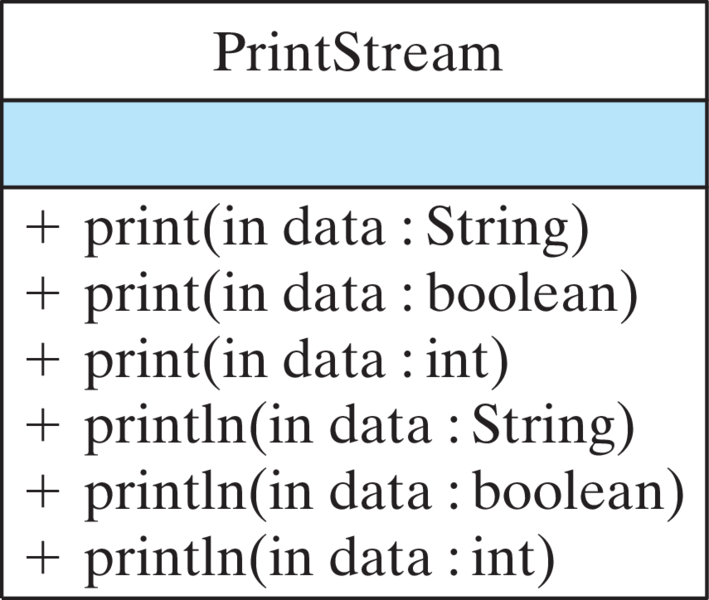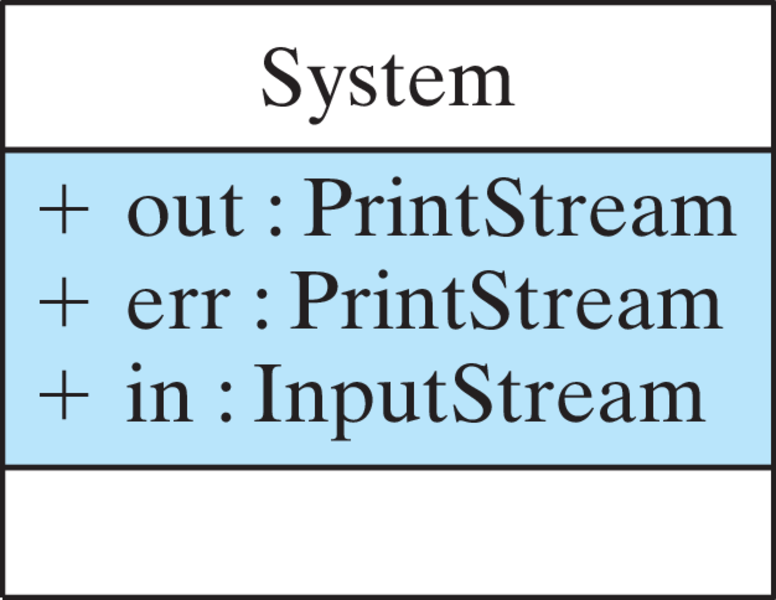Principle 1.7.4. EFFECTIVE DESIGN: Using the Java Library.
Learning how to use classes and objects from the Java class library is an important part of object-oriented programming in Java.
System and PrintStream classes, which are used for printing a program’s output.HelloWorld (Listing 1.5.1), use this type of interface.HelloWorldCanvas program (Listing 1.5.16), is an example of a GUI.java.io package. We have already seen how the output method println() is used to output a string to the console. For example, the following println() statementSystem.out.println("Hello, World");
java.io.PrintStream class is Java’s printing expert, so to speak. It contains a variety of print() and println() methods that can be used to print all of the various types of data we find in a Java program. A partial definition of PrintStream is shown in Figure 1.7.1. Note that in this case the PrintStream class has no attributes, just methods.
PrintStream class.print() and println() methods are instance methods of a PrintStream object, we can only use them by finding a PrintStream object and “telling” it to print data for us. As shown in Figure 1.7.2, Java’s java.lang.System class contains two public (+) PrintStream objects, System.out and System.err.
PrintStream class.System.err stream is used primarily for error messages, whereas the System.out stream is used for other printed output. Similarly, as its name suggests, the System.in object can be used to handle input, which will be covered in Chapter 2.print() and println() methods is that println() will also print a carriage return and line feed after printing its data, thereby allowing subsequent output to be printed on a new line. For example, the following statementsSystem.out.print("hello");
System.out.println("hello again");
System.out.println("goodbye");
hellohello again
goodbye
System.out.println() statements each of which prints a line of the verse. The complete program is shown in Listing 1.7.3. You can run the program in the self-study exercises below. public class OldMacDonald
{
public static void main(String args[]) // Main method
{
System.out.println("Old MacDonald had a farm");
System.out.println("E I E I O.");
System.out.println("And on his farm he had a duck.");
System.out.println("E I E I O.");
System.out.println("With a quack quack here.");
System.out.println("And a quack quack there.");
System.out.println("Here a quack, there a quack,");
System.out.println("Everywhere a quack quack.");
System.out.println("Old MacDonald had a farm");
System.out.println("E I E I O.");
} // End of main
} // End of OldMacDonald
OldMacDonald.java class.OldMacDonald class to “sing” one more verse of the song for an animal of your choice.********** * ** ** * * ** * * * * * * **** * *********